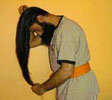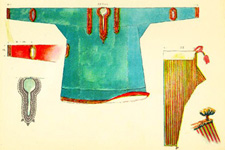WHY DO SIKHS WEAR TURBANS?
April 8, 2010
In 2003, on my first visit to Boston, somewhere between Hyatt Regency and West Street, I was surprised to hear someone say, “Sat Siri Akal” (‘God is Truth’), the standard Sikh greeting. A young man with his long hair tied back with a ribbon was smiling at me. I knew he was a Sikh because of the steel bangle dangling from his right wrist. I asked automatically, “What happened to your turban?”
Pointing over his shoulder at the store behind him, he said “I have been working here for couple of years now. When I wanted to apply for my green card for Permanent Residence, I asked them to recommend my case.”
“So?”
He replied, “They said, ‘Remove your turban and we will do so’.”
“I can see you have kept your hair.” I said.
“Yes, uncle. My hair is dear to me and I won’t cut it.”
For Americans like the store owner who employed this young man, public show of religious beliefs has caused controversy in every generation. When I first began coming to America in the sixties, many people doubted that John F. Kennedy could do a good job as President because of his Catholicism. Kennedy downplayed his religion, just as Larry Johnson downplays his Muslim faith today. This low-profile approach to religion does not work for Sikhs because their religious identity is expressed in their way of life, a bold brave statement with high personal standards.
 When Guru Gobind Singh, the Tenth Guru of the Sikhs, made the wearing of the Five Ks in March 1699 as their prominently visible identity and religious duty, he was creating hawks out of sparrows. Nay, he was creating lions out of sheep.
When Guru Gobind Singh, the Tenth Guru of the Sikhs, made the wearing of the Five Ks in March 1699 as their prominently visible identity and religious duty, he was creating hawks out of sparrows. Nay, he was creating lions out of sheep.
Lions out of sheep? Yes, the situation was not very different from the India of today facing Islamic terrorism. The Muslim rulers of India had made a law that non-Muslims dare not wear a sword or ride a horse or an elephant or a palanquin or wear a turban other than those who submitted to Islam. Thus, the minority Muslims forced the Hindus and Sikhs, a majority, to convert to Islam. As a challenge to the Muslim rule, the Tenth Guru ordained his Sikhs to keep the Five Ks.
The first K is Kesh – long uncut hair, a sign of spiritual evolution. The Guru knew that being of a very high spiritual norm was important if his followers were to be lions. With a mane like a lion, the Sikh could have a lion’s heart. In order to take good care of the hair, the turban is worn to cover it. I never go out without my turban.
The Guru knew that being of a very high spiritual norm was important if his followers were to be lions. With a mane like a lion, the Sikh could have a lion’s heart. In order to take good care of the hair, the turban is worn to cover it. I never go out without my turban.
 The second K is Kanga -a comb to keep the long uncut hair cleaned and aired. The other three Ks include the Kirpan – sword; a Kara, steel bangle; and Katchha, complicated white underwear.
The second K is Kanga -a comb to keep the long uncut hair cleaned and aired. The other three Ks include the Kirpan – sword; a Kara, steel bangle; and Katchha, complicated white underwear.
 The practical Sikh mind welcomes these daily reminders of the Tenth Guru’s teachings. The Five Ks to a pious Sikh are not mere ornaments but tools for living a righteous life.
The practical Sikh mind welcomes these daily reminders of the Tenth Guru’s teachings. The Five Ks to a pious Sikh are not mere ornaments but tools for living a righteous life.
 To deprive a Sikh of his turban would be like asking an American to give up his flag.
To deprive a Sikh of his turban would be like asking an American to give up his flag.